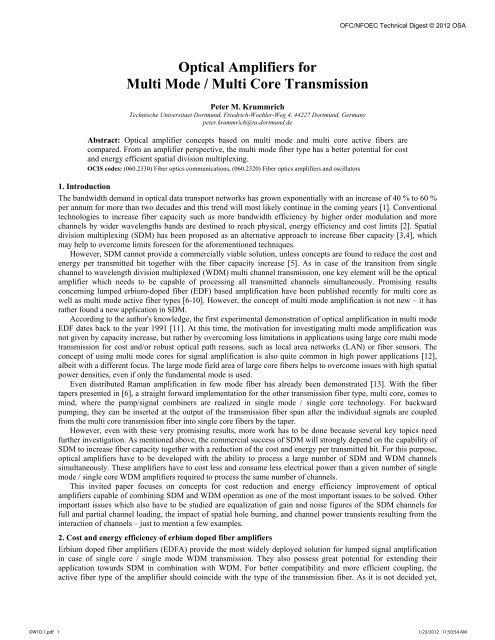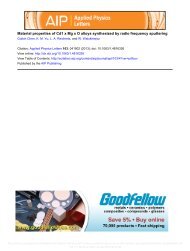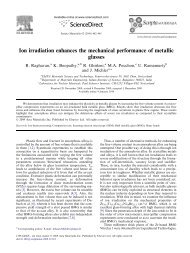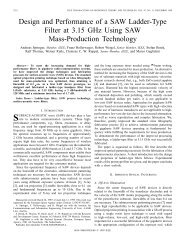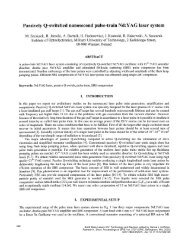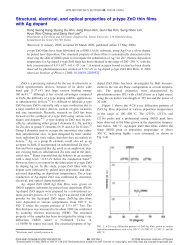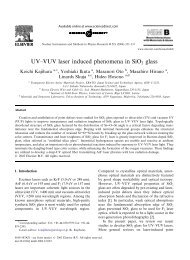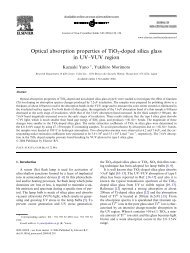Optical Amplifiers for Multi Mode / Multi Core Transmission
Optical Amplifiers for Multi Mode / Multi Core Transmission
Optical Amplifiers for Multi Mode / Multi Core Transmission
Create successful ePaper yourself
Turn your PDF publications into a flip-book with our unique Google optimized e-Paper software.
<strong>Optical</strong> <strong>Amplifiers</strong> <strong>for</strong><br />
<strong>Multi</strong> <strong>Mode</strong> / <strong>Multi</strong> <strong>Core</strong> <strong>Transmission</strong><br />
Peter M. Krummrich<br />
Technische Universitaet Dortmund, Friedrich-Woehler-Weg 4, 44227 Dortmund, Germany<br />
peter.krummrich@tu-dortmund.de<br />
OFC/NFOEC Technical Digest © 2012 OSA<br />
Abstract: <strong>Optical</strong> amplifier concepts based on multi mode and multi core active fibers are<br />
compared. From an amplifier perspective, the multi mode fiber type has a better potential <strong>for</strong> cost<br />
and energy efficient spatial division multiplexing.<br />
OCIS codes: (060.2330) Fiber optics communications, (060.2320) Fiber optics amplifiers and oscillators<br />
1. Introduction<br />
The bandwidth demand in optical data transport networks has grown exponentially with an increase of 40 % to 60 %<br />
per annum <strong>for</strong> more than two decades and this trend will most likely continue in the coming years [1]. Conventional<br />
technologies to increase fiber capacity such as more bandwidth efficiency by higher order modulation and more<br />
channels by wider wavelengths bands are destined to reach physical, energy efficiency and cost limits [2]. Spatial<br />
division multiplexing (SDM) has been proposed as an alternative approach to increase fiber capacity [3,4], which<br />
may help to overcome limits <strong>for</strong>eseen <strong>for</strong> the a<strong>for</strong>ementioned techniques.<br />
However, SDM cannot provide a commercially viable solution, unless concepts are found to reduce the cost and<br />
energy per transmitted bit together with the fiber capacity increase [5]. As in case of the transition from single<br />
channel to wavelength division multiplexed (WDM) multi channel transmission, one key element will be the optical<br />
amplifier which needs to be capable of processing all transmitted channels simultaneously. Promising results<br />
concerning lumped erbium-doped fiber (EDF) based amplification have been published recently <strong>for</strong> multi core as<br />
well as multi mode active fiber types [6-10]. However, the concept of multi mode amplification is not new – it has<br />
rather found a new application in SDM.<br />
According to the author's knowledge, the first experimental demonstration of optical amplification in multi mode<br />
EDF dates back to the year 1991 [11]. At this time, the motivation <strong>for</strong> investigating multi mode amplification was<br />
not given by capacity increase, but rather by overcoming loss limitations in applications using large core multi mode<br />
transmission <strong>for</strong> cost and/or robust optical path reasons, such as local area networks (LAN) or fiber sensors. The<br />
concept of using multi mode cores <strong>for</strong> signal amplification is also quite common in high power applications [12],<br />
albeit with a different focus. The large mode field area of large core fibers helps to overcome issues with high spatial<br />
power densities, even if only the fundamental mode is used.<br />
Even distributed Raman amplification in few mode fiber has already been demonstrated [13]. With the fiber<br />
tapers presented in [6], a straight <strong>for</strong>ward implementation <strong>for</strong> the other transmission fiber type, multi core, comes to<br />
mind, where the pump/signal combiners are realized in single mode / single core technology. For backward<br />
pumping, they can be inserted at the output of the transmission fiber span after the individual signals are coupled<br />
from the multi core transmission fiber into single core fibers by the taper.<br />
However, even with these very promising results, more work has to be done because several key topics need<br />
further investigation. As mentioned above, the commercial success of SDM will strongly depend on the capability of<br />
SDM to increase fiber capacity together with a reduction of the cost and energy per transmitted bit. For this purpose,<br />
optical amplifiers have to be developed with the ability to process a large number of SDM and WDM channels<br />
simultaneously. These amplifiers have to cost less and consume less electrical power than a given number of single<br />
mode / single core WDM amplifiers required to process the same number of channels.<br />
This invited paper focuses on concepts <strong>for</strong> cost reduction and energy efficiency improvement of optical<br />
amplifiers capable of combining SDM and WDM operation as one of the most important issues to be solved. Other<br />
important issues which also have to be studied are equalization of gain and noise figures of the SDM channels <strong>for</strong><br />
full and partial channel loading, the impact of spatial hole burning, and channel power transients resulting from the<br />
interaction of channels – just to mention a few examples.<br />
2. Cost and energy efficiency of erbium doped fiber amplifiers<br />
Erbium doped fiber amplifiers (EDFA) provide the most widely deployed solution <strong>for</strong> lumped signal amplification<br />
in case of single core / single mode WDM transmission. They also possess great potential <strong>for</strong> extending their<br />
application towards SDM in combination with WDM. For better compatibility and more efficient coupling, the<br />
active fiber type of the amplifier should coincide with the type of the transmission fiber. As it is not decided yet,<br />
OW1D.1.pdf 1 1/23/2012 11:50:54 AM
whether the multi core or the multi mode fiber type will feature better transmission per<strong>for</strong>mance, both types should<br />
also be considered <strong>for</strong> optical amplification. Fig. 1 shows a schematic sketch of the two fiber types – a fiber with<br />
multiple cores, each guiding only a single mode (MSC) and a fiber with a single core, which guides multiple modes<br />
(SMC).<br />
<strong>Multi</strong> single mode core fiber (MSC)<br />
Single multi mode core fiber (SMC)<br />
Fig. 1: Schematic sketch of multi core and multi mode fiber types<br />
The optimization of cost and energy efficiency should consider the purpose of the amplifier stage – whether the<br />
main function consists of low noise amplification of low power signals occurring at the output of a transmission<br />
span as in case of a preamplifier stage or boosting the channel powers to the relatively high levels required at the<br />
input of a transmission fiber span as in case of a booster stage.<br />
For the preamplifier stage, the main design target is given by realizing a high level of inversion of the lower and<br />
upper laser level erbium ion population densities in a cost and energy efficient way. The required spatial pump<br />
power density <strong>for</strong> this purpose can be estimated from a simplified rate equation model [14]. A comparison of the<br />
total pump powers required to achieve a level of inversion resulting in low noise amplification with different active<br />
fiber types and designs has revealed that the multi mode fiber type possesses a better potential <strong>for</strong> pump power<br />
efficiency than the multi core fiber type.<br />
Fig. 2 shows a plot of the required pump powers <strong>for</strong> the case of direct pumping of the cores in multi core and<br />
multi mode active fibers. For the multi core fiber, the required pump power increases proportionally to the number<br />
of cores. If the modes of the multi mode fiber are counted with two orthogonal polarizations each to achieve the<br />
same capacity as in case of the multi core fiber, the required pump power also increases approx. proportional to the<br />
number of modes, but with a reduced slope. The lower total pump power required <strong>for</strong> the multi mode fiber type<br />
compared to a multi core fiber with the same capacity results from the higher packing density of modes. A lower<br />
fraction of the pump radiation is guided outside the core area, where it does not contribute to the inversion of erbium<br />
ions.<br />
Power in mW<br />
1400<br />
1200<br />
1000<br />
800<br />
600<br />
400<br />
200<br />
0<br />
0 10 20 30 40<br />
No. of modes<br />
<strong>Multi</strong> core fiber<br />
<strong>Multi</strong> mode fiber<br />
Fig. 2: Total pump power required <strong>for</strong> low noise amplification in a preamplifier stage<br />
as a function of the number of modes in multi core and multi mode fiber types<br />
OFC/NFOEC Technical Digest © 2012 OSA<br />
According to the comparison, preamplifier stages with the multi mode fiber type need approx. 30 % less total pump<br />
power than stages processing the same number of SDM and WDM channels with a multi core active fiber. The<br />
actual power ratio depends on the design of the two active fiber types. The resulting reduction in required electrical<br />
power supply is by far smaller than the one achievable by replacing single channel optoelectronic regenerators with<br />
multi channel optical WDM amplifiers. Nevertheless, it can provide a helpful contribution towards the reduction of<br />
cost and energy per bit. <strong>Multi</strong> core amplifiers with a given number of cores basically need the same total pump<br />
power as individual single core WDM amplifiers <strong>for</strong> the same number of channels. The reduction in pump power<br />
achievable by processing all channels in a single multi mode core, which can be considered as integration, results in<br />
OW1D.1.pdf 2 1/23/2012 11:50:54 AM
OFC/NFOEC Technical Digest © 2012 OSA<br />
a reduction of the cost and energy per bit compared to the case with parallel single core and single mode WDM<br />
amplifiers.<br />
Further improvement of cost and energy efficiency can be achieved by amplifier module design optimization [8].<br />
The cores of multi mode EDF can be pumped using multi mode pump lasers. Direct pumping of the cores of multi<br />
core fibers needs single mode pump sources and cladding pump approaches are rather inefficient in this case. The<br />
potentially better electrical to optical power conversion efficiency of multi mode pumps favors using the multi mode<br />
active fiber type in preamplifier applications.<br />
Similar arguments apply to the optimization of booster stages, where most attention has to be paid to the pump to<br />
signal power conversion efficiency due to the high total signal output powers. Also in this application, the multi<br />
mode active fiber type provides potential energy efficiency advantages due to its better compatibility with multi<br />
mode pump sources.<br />
3. Distributed Raman amplification<br />
A similar comparison of the pump power efficiency of multi mode and multi core active fiber types based on the<br />
required pump spatial power density has also been carried <strong>for</strong> distributed Raman amplification in the transmission<br />
fiber [14]. Cladding pump approaches were found to result in excessively high total pump power requirements of<br />
several ten Watts. For direct pumping of the cores, still several Watts of total pump power have to be expected.<br />
Total pump powers predicted by the spatial power density based estimation agree well with the experimental results<br />
reported in [13].<br />
Total pump powers of several Watts are not desirable but can be realized with currently available pump<br />
technology. Third order Raman pumps are already using such total power levels. With respect to the comparison of<br />
multi mode and multi core active fiber types, a better pump power efficiency was found <strong>for</strong> the multi mode type as<br />
in case of the erbium doped fiber. Again the higher packing density of modes in the multi mode fiber leads to<br />
reduced total pump powers.<br />
3. Summary and conclusions<br />
The realization of cost and energy efficient optical amplifiers will play a crucial role <strong>for</strong> the commercial success of<br />
deploying spatial division multiplexing <strong>for</strong> increasing fiber capacity. Results from concept studies comparing<br />
amplifier designs based on multi mode and multi core active fiber types reveal a better potential of the multi mode<br />
fiber type <strong>for</strong> lumped erbium-doped fiber based amplification as well as distributed Raman amplification in the<br />
transmission fiber. From an amplifier perspective, the multi mode fiber type has to be considered as the better<br />
candidate <strong>for</strong> cost and energy efficient fiber capacity increases based on spatial division multiplexing.<br />
4. References<br />
[1] A. Chraplyvy: "The Coming Capacity Crunch" 35th European Conference on <strong>Optical</strong> Communication (ECOC 2009), paper 1.0.2<br />
[2] P. J. Winzer: "Challenges and evolution of optical transport networks", 36th European Conference on <strong>Optical</strong> Communication (ECOC<br />
2010), Torino, Italy, Sept. 19 – 23, We.8.D.1<br />
[3] S. Berdaguè, P. Facq: "<strong>Mode</strong> Division <strong>Multi</strong>plexing In <strong>Optical</strong> Fibers", Applied Optics (1982), Vol. 21, No. 11, pp. 1950 – 1955<br />
[4] M. Koshiba, K. Saitoh, Y. Kokubun: "Heterogeneous multi-core fibers: proposal and design principle", IEICE Electronics Express (2009),<br />
Vol. 6, No. 2, pp. 98 – 103<br />
[5] P. M. Krummrich: "Spatial multiplexing <strong>for</strong> high capacity transport", <strong>Optical</strong> Fiber Technology (2011), in print<br />
[6] K. S. Abedin, T. F. Taunay, M. Fishteyn, M. F. Yan, B. Zhu, J. M. Fini, E. M. Monberg, F.V. Dimarcello, and P.W. Wisk: "Amplification<br />
and noise properties of an erbium-doped multicore fiber amplifier", Optics Express (2011), Vol. 19, Iss. 17, pp. 16715–16721<br />
[7] N. Bai, E. Ip, T. Wang, G. Li: "<strong>Multi</strong>mode fiber amplifier with tunable modal gain using a reconfigurable multimode pump", Optics Express<br />
(2011), Vol. 19, Iss. 17, pp. 16601–16611<br />
[8] P. M. Krummrich: "<strong>Optical</strong> amplification and optical filter based signal processing <strong>for</strong> cost and energy efficient spatial multiplexing",<br />
Optics Express (2011), Vol. 19, Iss. 17, pp. 16636–16652<br />
[9] Y. Yung, S.-u. Alam, Z. Li, A. Dhar, D. Giles, I. Giles, J. Sahu, L. Grüner-Nielsen, F. Poletti., D. Richardson: "First demonstration of<br />
multimode amplifier <strong>for</strong> spatial division multiplexed transmission systems", 37th European Conference on <strong>Optical</strong> Communication (ECOC<br />
2011), Geneva, Switzerland, Sept. 18 – 22, Th.13.K.4<br />
[10] E. Ip, N. Bai, Y.-K. Huang, E. Mateo, F. Yaman, S. Bickham, H.-Y. Tam, C. Lu, M.-J. Li, S. Ten, A. Pak Tao Lau, V. Tse, G.-D. Peng, C.<br />
Montero, X. Prieto, G. Li: "88 x 3 x 112-Gb/s WDM transmission over 50-km of three-mode fiber with inline multimode fiber amplifier",<br />
37th European Conference on <strong>Optical</strong> Communication (ECOC 2011), Geneva, Switzerland, Sept. 18 – 22, Th.13.C.2<br />
[11] G. Nykolak, S. A. Kramer, J. R. Simpson, D. J. DiGiovanni, C. R. Giles, H. M. Presby: "An Erbium-Doped <strong>Multi</strong>mode Fiber Amplifier",<br />
IEEE Trans. Phot. Technol. Lett. (1991), Vol. 3, No. 12, Dec., pp. 1079 – 1081<br />
[12] C. D. Stacey, J. M. Jenkins: "Demonstration of fundamental mode propagation in highly multimode fibre <strong>for</strong> high power EDFAs",<br />
Conference on Lasers and Electro-Optics Europe (CLEO 2005), Munich, Germany, June 17, p. 558<br />
[13] R. Ryf, A. Sierra, R.-J. Essiambre, S. Randel, A. Gnauck, C. A. Bolle, M. Esmaeelpour, P. J. Winzer, R. Delbue, P. Pupalaikis, A. Sureka,<br />
D. Peckham, A. McCurdy, R. Lingle: "<strong>Mode</strong>-equalized distributed Raman amplification in 137-km few-mode fiber", 37th European<br />
Conference on <strong>Optical</strong> Communication (ECOC 2011), Geneva, Switzerland, Sept. 18 – 22, Th.13.K.5<br />
[14] P. M. Krummrich, K. Petermann: "Evaluation of Potential <strong>Optical</strong> Amplifier Concepts <strong>for</strong> Coherent <strong>Mode</strong> <strong>Multi</strong>plexing", Conference on<br />
<strong>Optical</strong> Fiber Communication (OFC 2011), March 6-10, Los Angeles, CA, USA, OMH5<br />
OW1D.1.pdf 3 1/23/2012 11:50:54 AM


